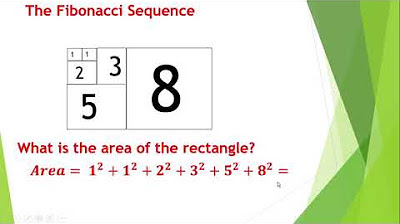Golden Ratio = Mind Blown!
Summary
TLDRThis video script delves into the Golden Ratio, also known as 'Phi,' a mathematical phenomenon found in design and nature. It explains the Fibonacci sequence as a numeric representation of the Golden Ratio, which approximates a 1:1.6 ratio. The script highlights the ratio's prevalence in natural occurrences, human anatomy, and artistic designs, suggesting it contributes to aesthetic appeal and functionality. It challenges viewers to recognize the Golden Ratio in everyday life, hinting at a deeper connection between mathematics and the world around us.
Takeaways
- 📚 The Golden Ratio, also known as 'Phi', is a mathematical and design phenomenon that is represented by the Fibonacci sequence.
- 🔢 The Fibonacci sequence is generated by starting with 0 and 1, and each subsequent number is the sum of the two preceding ones (e.g., 0, 1, 1, 2, 3, 5, 8...).
- 🌀 The Golden Ratio is approximately 1.6, and it is observed when the ratio of two quantities is consistent with the sequence's expansion rate.
- 🌿 The Golden Ratio is prevalent in nature, influencing the growth patterns of plants, the arrangement of seeds, and the number of petals in flowers.
- 🌪 The ratio is also found in large-scale natural phenomena such as the spirals of storms and the structure of galaxies.
- 💪 The human body exhibits the Golden Ratio in various proportions, from the length of limbs to the spacing of teeth and the structure of the eye.
- 🎶 The Golden Ratio has been used in music, with the arrangement of piano keys reflecting the Fibonacci sequence.
- 🏛 In architecture and art, the Golden Ratio has been employed to create aesthetically pleasing and harmonious designs, as seen in ancient Greek temples.
- 🎨 Famous artists like Leonardo da Vinci and Michelangelo incorporated the Golden Ratio into their works for balance and visual appeal.
- 🏢 The ratio is used in modern design, from logos and branding to product design, as it is considered pleasing to the eye.
- 🔍 The speaker encourages viewers to observe and identify the Golden Ratio in everyday life and nature, suggesting it can enhance design awareness and potentially change one's perspective.
Q & A
What is the Golden Ratio also known as?
-The Golden Ratio is also referred to as 'Phi'.
How is the Golden Ratio related to the Fibonacci sequence?
-The Golden Ratio is the ratio that emerges from the Fibonacci sequence, which is a series of numbers where each number is the sum of the two preceding ones, starting from 0 and 1.
What is the basic formula to generate the Fibonacci sequence?
-The basic formula to generate the Fibonacci sequence is to start with 0 and 1, and then for each subsequent number, add the last two numbers in the sequence together (e.g., 0+1=1, 1+1=2, 1+2=3).
What is the approximate ratio of the Golden Ratio?
-The approximate ratio of the Golden Ratio is 1 to 1.6.
How does the Golden Ratio manifest in nature?
-The Golden Ratio manifests in nature through the growth patterns and spirals of plants, the seed patterns, the number of petals in flowers, and even in the spirals of storms like tornadoes and hurricanes.
How is the Golden Ratio reflected in the human body?
-The Golden Ratio is reflected in the human body in the proportions of limbs, such as the distance from the shoulder to the elbow compared to the elbow to the fingertips, and also in the spacing of knuckles and the proportions of the face and body.
What role does the Golden Ratio play in the design of musical instruments?
-The Golden Ratio plays a role in the design of musical instruments by influencing the arrangement of keys on a piano and the alignment of musical scales and notes, which align with the Fibonacci sequence.
Which ancient texts are believed to incorporate the Golden Ratio in their design measurements?
-Ancient Biblical texts, such as the design measurements of Noah's Ark and the Ark of the Covenant, are believed to incorporate the Golden Ratio.
How has the Golden Ratio been used in art and architecture?
-The Golden Ratio has been used in art and architecture to create aesthetically pleasing compositions, as seen in the design of Greek temples like the Parthenon and in the works of artists such as Leonardo da Vinci and Michelangelo.
Why do artists avoid centering everything in their artwork when using the Golden Ratio?
-Artists avoid centering everything in their artwork when using the Golden Ratio because it is believed to create more dynamic and visually interesting compositions, which are more pleasing to the eye.
How is the Golden Ratio used in modern product design, logos, and branding?
-The Golden Ratio is used in modern product design, logos, and branding because it is considered pleasing to the eye and can serve as a template for solving various design problems, enhancing the visual appeal of products and brands.
Outlines

このセクションは有料ユーザー限定です。 アクセスするには、アップグレードをお願いします。
今すぐアップグレードMindmap

このセクションは有料ユーザー限定です。 アクセスするには、アップグレードをお願いします。
今すぐアップグレードKeywords

このセクションは有料ユーザー限定です。 アクセスするには、アップグレードをお願いします。
今すぐアップグレードHighlights

このセクションは有料ユーザー限定です。 アクセスするには、アップグレードをお願いします。
今すぐアップグレードTranscripts

このセクションは有料ユーザー限定です。 アクセスするには、アップグレードをお願いします。
今すぐアップグレード5.0 / 5 (0 votes)






